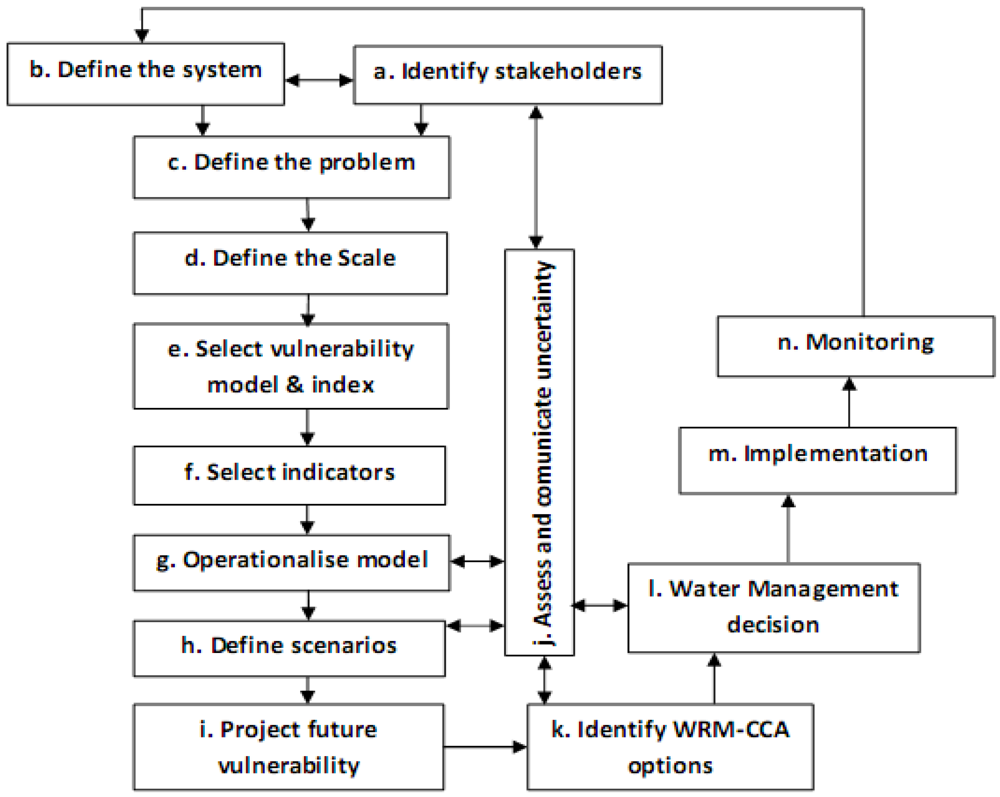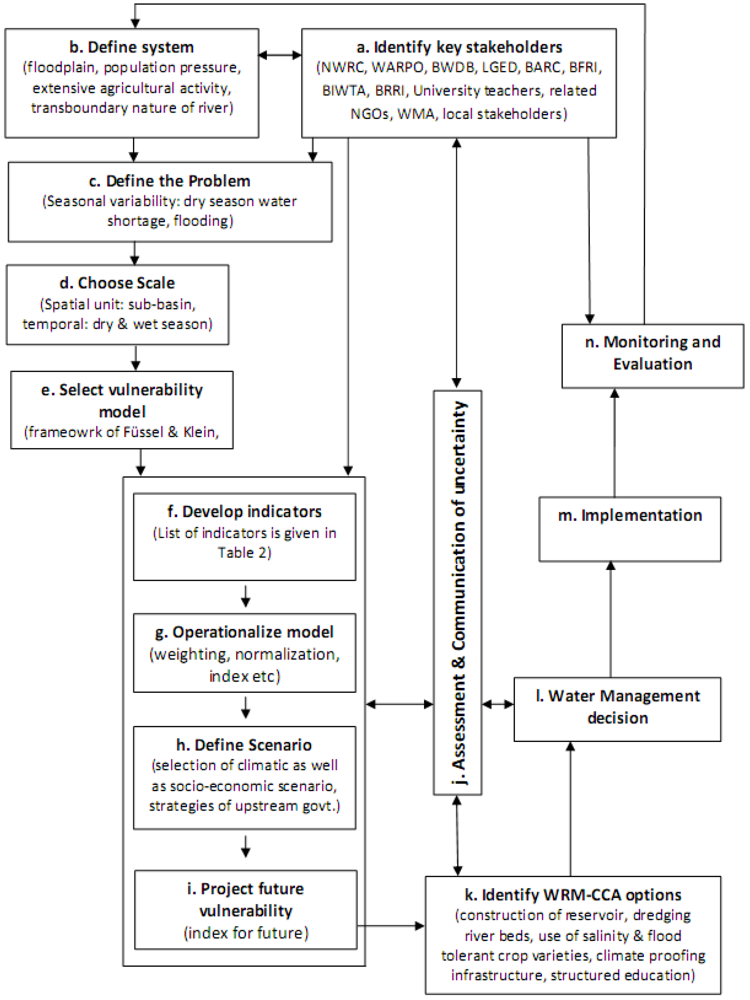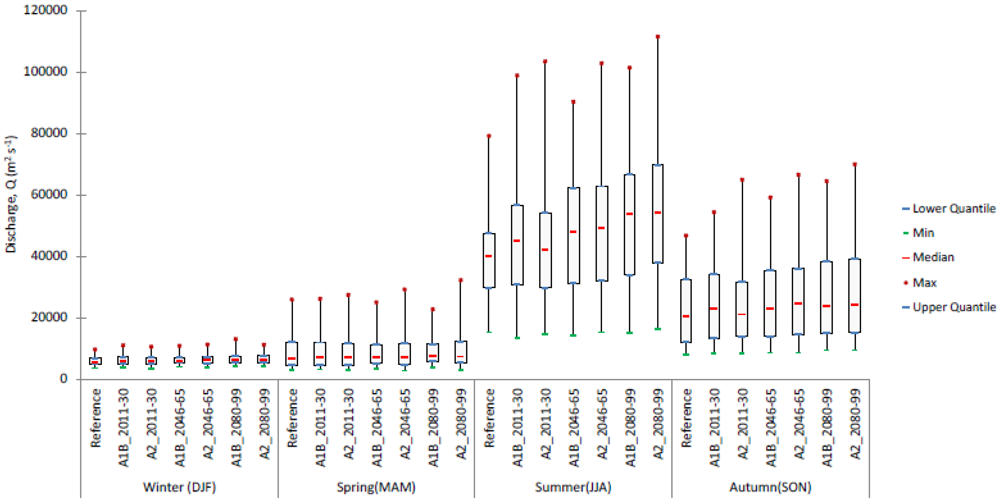Climate Change Adaptation and Vulnerability Assessment of Water Resources Systems in Developing Countries: A Generalized Framework and a Feasibility Study in Bangladesh
Abstract
:1. Introduction

2. Vulnerability Assessment Models and Frameworks
2.1. Framing the Concept of Vulnerability
2.2. System View in Water Resources Management and Decision Making
2.3. Indices for the Assessment of Vulnerability of Water Resources

3. Proposed Framework of Vulnerability Assessment for Water Resources System

4. Feasibility Assessment of Proposed Framework in Lower Brahmaputra River Basin (LBRB) Context
4.1. Lower Brahmaputra River Basin (LBRB): Context of Vulnerability Assessment
4.2. Design of the Feasibility Study
| Categorization of participants in terms of their current activities | Number |
|---|---|
| University professors who are also responsible for water resources planning for the government of Bangladesh | 3 |
| Representative from the government organizations who are dealing with large scale water projects | 3 |
| Representative from the government organizations who are dealing with small scale water projects | 4 |
| NGO representatives who are responsible for water planning and management | 7 |
| University teachers (Lecturer & Asst. Professor) with research interest in water management | 5 |
| PhD researchers with research topic related to water management in Bangladesh | 5 |
| Representative from local government | 3 |
4.3. Experts’ Judgement on Proposed Framework
4.4. Results of the Feasibility Study and Revised Framework for LBRB


| Main Components | Sub-components | Acronym | Definition and selected indicator |
|---|---|---|---|
| Exposure | Water availability | WA | Future available water was calculated through assessing future riverflow of lower Brahmaputra (at Bahadurabad station) under different climate scenario (A1B & A2). Indicator: Riverflow of Brahmaputra at Bahadurabad station (m3/s); source: [59]. |
| Sensitivity | Water Demand | WD | Agricultural, domestic, industrial and in stream water demand increase the sensitivity for the study area. Indicator: Total water demand, which is the aggregation of agricultural, domestic, industrial and instream water demand (m3/s); source: [68]. |
| Infrastructure pressures at Upstream | IP | The sensitivity induced by alterations of the river flow at upstream deriving from barrages, dams, etc. which may increase the sensitivity. Indicator: Hydroelectrical installed capacity (MW); source: own elaborations on data from the development plans of the Central Electrical Authority of India (http://www.cea.nic.in/) | |
| Forest Cover at upstream | FC | One of the most important strategies for controlling runoff and erosion risks, thus limiting the probability of flood events downstream. Indicator: Area forest cover at north-east India (km2); source: [69]. | |
| Resilience | Agricultural production | AP | An activity that contributes to the maintenance of land with positive potential for limiting the impacts of climate change. Indicator: amount of rice production (ton), a proxy of agricultural production; source: BARC. |
| Coping capacity | Water Governance | WG | The status of water governance can determine the capacity for the management of various problems of water resources. Indicator: perceived trend of composite water governance (numeric value between 0 to 1); Source: [70] |
| Poverty | P | A second index of the economic wealth of the population, here derived from the projections of the indicator “incidence of poverty”; source: [71]. |

5. Conclusions
Acknowledgments
Supplementary Files
References and Notes
- Millennium Ecosystem Assessment, Ecosystem and Human Wellbeing: Current State and Trends; Island Press: Washington, DC, USA, 2005.
- UN-Water. Key Messages on Climate Change and Water Prepared for COP-15; UN-Water: New York, NY, USA. Available online: http://www.unwater.org/downloads/UNWclimatechange_EN.pdf (accessed on 09 February 2012).
- Bates, B.C.; Kundzewicz, Z.W.; Wu, S.; Palutikof, J.P. Climate Change and Water; Technical Paper for Intergovernmental Panel on Climate Change: Geneva, Switzerland, 2008. [Google Scholar]
- Chalecki, E.L.; Gleick, P.H. A framework of ordered climate effects on water resources: A comprehensive bibliography. J. Am. Water Resour. As. 1999, 35, 1657–1665. [Google Scholar]
- Kundzewicz, Z.W.; Mata, L.J.; Arnell, N.W.; Döll, P.; Kabat, P.; Jiménez, B.; Miller, K.A.; Oki, T.; Sen, Z.; Shiklomanov, I.A. Freshwater resources and their management. In Climate Change 2007: Impacts, Adaptation and Vulnerability. Contribution of Working Group II to the Fourth Assessment Report of the Intergovernmental Panel on Climate Change; Parry, M.L., Canziani, O.F., Palutikof, J.P., van der Linden, P.J., Hanson, C.E., Eds.; Cambridge University Press: Cambridge, UK, 2007; pp. 173–210. [Google Scholar]
- Thywissen, K. Components of Risk: A Comparative Glossary; Studies of the University: Research, Counsel, Education (SOURCE) Publication Series No 2; United Nations University-Institute for Environment and Human Security (UNU-EHS): Bonn, Germany, 2006. [Google Scholar]
- Cutter, S.L. Vulnerability to environmental hazards. Prog. Hum. Geog. 1996, 20, 529–539. [Google Scholar]
- Jones, R.N. An environmental risk assessment/management framework for climate change impact assessments. Nat. Hazards 2001, 23, 197–230. [Google Scholar]
- Brooks, N.; Adger, W.N.; Kelly, P.M. The determinants of vulnerability and adaptive capacity at the national level and the implications for adaptation. Global Environ. Change 2005, 15, 151–163. [Google Scholar]
- Turner, B.L.; Kasperson, R.E.; Matsone, P.A.; McCarthy, J.J.; Corell, R.W.; Christensen, L.; Eckley, L.; Kasperson, J.X.; Luerse, A; Martello, M.L.; et al. A framework for vulnerability analysis in sustainability science. Proc. Natl. Acad. Sci. USA 2003, 100, 8074–8079. [Google Scholar]
- Luers, A.L. The surface of vulnerability: An analytical framework for examining environmental change. Global Environ. Change 2005, 15, 214–223. [Google Scholar]
- Füssel, H.M.; Klein, R.J.T. Climate change vulnerability assessments: An evolution of conceptual thinking. Climatic Change 2006, 75, 301–329. [Google Scholar]
- Füssel, H.M. Vulnerability: A generally applicable conceptual framework for climate change research. Global Environ. Change 2007, 17, 155–167. [Google Scholar]
- Moss, R.H.; Brenkert, A.L.; Malone, E.L. Vulnerability to Climate Change: A Quantitative Approach; Technical Report PNNL-SA-33642; Pacific Northwest National Laboratory: Richland, WA, USA, 2001. [Google Scholar]
- Patt, A.G.; Schroter, D.; de la Vega-Leinert, A.C.; Klein, R.J.T. Vulnerability research and assessment to support adaptation and mitigation: Common themes from the diversity of approaches. In Environmental Vulnerability Assessment; Patt, A.G., Schroter, D., de la Vega-Leinert, A.C., Klein, R.J.T., Eds.; Earthscan: London, UK, 2008. [Google Scholar]
- Hinkel, J. Indicators of vulnerability and adaptive capacity—Towards a clarification of the science-policy interface. Global Environ. Change 2011, 21, 198–208. [Google Scholar]
- Simonovic, S.P. Water Resources Management: A System View. Available online: http://www.siwi.org/documents/Resources/Water_Front_Articles/2009/WRMASystemsView.pdf (accessed on 9 February 2012).
- Hyde, K.M.; Maier, H.R.; Colby, C.B. Reliability-based approach to multicriteria decision analysis for water resources. J. Water Res. Pl-ASCE 2004, 130, 429–438. [Google Scholar] [CrossRef]
- Tessendorff, H. The Dublin statement on water and sustainable development. International Conference on Water and Environment, Dublin, Ireland, 29–31 December 1992. Available online: http://www.inpim.org/files/Documents/DublinStatmt.pdf (accessed on 8 February 2012).
- Vörösmarty, C.J.; Green, P.; Salisbury, J.; Lammers, R.B. Global water resources: Vulnerability from climate change and population growth. Science 2000, 289, 284–288. [Google Scholar]
- Babel, M.S.; Wahid, S.M. Freshwater Under Threat: South Asia—Vulnerability Assessment of Freshwater Resources to Environmental Change; United Nations Environment Programme: Nairobi, Kenya, 2009. [Google Scholar]
- Hamouda, M.A.; Nour El-Din, M.M.; Moursy, F.I. Vulnerability assessment of water resources system in the Eastern Nile Basin. Water Resour. Manag. 2009, 23, 2697–2725. [Google Scholar]
- Hurd, B.; Leary, N.; Jones, R.; Smith, J. Relative regional vulnerability of water resources to climate change. J. Am. Water Resour. Assoc. 1999, 35, 1399–1409. [Google Scholar]
- Sullivan, C.A. Quantifying water vulnerability: A multi-dimensional approach. Stoch. Env. Res. Risk Assess. 2011, 25, 627–640. [Google Scholar]
- Pandey, V.P.; Babel, M.S.; Kazama, F. Analysis of a Nepalese water resources system: Stress, adaptive capacity and vulnerability. Water Sci. Technol. 2009, 9, 213–222. [Google Scholar]
- Gober, P.; Kirkwood, C.W. Vulnerability assessment of climate-induced water shortage in Phoenix. Proc. Natl. Acad. Sci. USA 2010, 107, 21295–21299. [Google Scholar]
- Pandey, V.P.; Babel, M.S.; Shrestha, S.; Kazama, F. Vulnerability of freshwater resources in large and medium Nepalese river basins to environmental change. Water Sci. Technol. 2010, 61, 1525–1534. [Google Scholar]
- Pandey, V.P.; Babel, M.S.; Shrestha, S.; Kazama, F. A framework to assess adaptive capacity of the water resources system in Nepalese river basins. Ecol. Indic. 2011, 11, 480–488. [Google Scholar]
- Balica, S.F.; Douben, N.; Wright, N.G. Flood vulnerability indices at varying spatial scales. Water Sci. Technol. 2009, 60, 2571–2580. [Google Scholar]
- Birkmann, J. Measuring vulnerability to promote disaster-resilient societies: Conceptual frameworks and definitions. In Measuring Vulnerability to Natural Hazards—Towards Disaster Resilient Societies; Birkmann, J., Ed.; United Nations University Press: Tokyo, Japan, 2006; pp. 9–54. [Google Scholar]
- Adger, W.N. Vulnerability. Global Environ. Change 2006, 16, 268–281. [Google Scholar]
- Gallopín, G.C. Linking between vulnerability, resilience and adaptive capacity. Global Environ. Change 2006, 16, 293–303. [Google Scholar]
- Wisner, B.; Blaikie, P.; Cannon, T.; Davis, I. At Risk: Natural Hazards, People’s Vulnerability, and Disasters, 2nd ed; Routledge: London, UK, 2004. [Google Scholar]
- Bogardi, J.; Birkmann, J. Vulnerability assessment: The first step towards sustainable risk reduction. In Disaster and Society—From Hazard Assessment to Risk Reduction; Malzahn, D., Plapp, T., Eds.; Logos Verlag Berlin: Berlin, Germany, 2004; pp. 75–82. [Google Scholar]
- Cardona, O.D. Estimación Holística del Riesgo Sísmico Utilizando Sistemas Dinámicos Complejos. Ph.D. Dissertation, Technical University of Catalonia, Barcelona, Spain, September 2001. [Google Scholar]
- Bohle, H.G. Vulnerability and criticality: Perspective from social geography. In IHDP Update 2/2001; Dyck, E., Ed.; International Human Dimensions Programme on Global Environmental Change: Bonn, Germany, 2001; pp. 3–5. [Google Scholar]
- Eakin, H.; Tompkins, E.L.; Nelson, D.R.; Anderies, J.M. Hidden costs and disparate uncertainties: Trade-offs in approaches to climate policy. In Adapting to Climate Change: Thresholds, Values, Governance; Adger, W.N., Lorenzoni, I., O’Brien, K.L., Eds.; Cambridge University Press: Cambridge, UK, 2009; pp. 212–226. [Google Scholar]
- Torry, W.I.; Anderson, W.A.; Bain, D.; Otway, H.J.; Souza, F.D.; Keefe, P.O. Anthropological studies in hazardous environments: Past trends and new horizons. Curr. Anthropol. 1979, 20, 515–540. [Google Scholar]
- Torry, W.I. Bureaucracy, community, and natural disasters. Hum. Organ. 1978, 37, 302–308. [Google Scholar]
- Mercer, J. Disaster risk reduction or climate change adaptation: Are we reinventing the wheel? J. Int. Dev. 2010, 22, 247–264. [Google Scholar] [CrossRef]
- Thomalla, F.; Downing, T.; Siegfried, E.S.; Han, G.; Rockström, J. Reducing hazard vulnerability: Towards a common approach between disaster risk reduction and climate adaptation. Disasters 2006, 30, 39–48. [Google Scholar]
- Renaud, F.; Perez, R. Climate change vulnerability and adaptation assessments. Sustain. Sci. 2010, 5, 155–157. [Google Scholar]
- UN/ISDR, Living With Risk—A Global Review of Disaster Reduction Initiatives; UN/ISDR: Geneva, Switzerland, 2004.
- IPCC, Summary for the policy makers. In Climate Change 2007: Impacts, Adaptation and Vulnerability. Contribution of Working Group II to the Fourth Assessment Report of the Intergovernmental Panel on Climate Change; Parry, M.L.; Canziani, O.F.; Palutikof, J.P.; van der Linden, P.J.; Hanson, C.E. (Eds.) Cambridge University Press: Cambridge, UK, 2007; pp. 7–22.
- IPCC, Annex B: Glossary of terms. In Climate Change 2001: Impacts, Adaptation and Vulnerability; McCarthy, J.J.; Canziani, O.F.; Leary, N.A.; Dokken, D.J.; White, K.S. (Eds.) Cambridge University Press: Cambridge, UK, 2001; p. 995.
- UN-Water, Status Report on Integrated Water Resources Management and Water Efficiency Plans for the 16th session of the Commission on Sustainable Development; UN-Water: New York, NY, USA, 2008.
- GWP-TAC, Integrated Water Resources Management; Background Paper No. 4; Global Water Partnership/Technical Advisory Committee: Stockholm, Sweden, 2000.
- UNESCO, Water in a Changing World; The United Nations World Water Development Report 3, World Water Assessment Programme (WWAP); UNESCO Publishing: Paris, France; Earthscan: London, UK, 2009.
- Oki, T.; Agata, Y.; Kanae, S.; Saruhashi, T.; Yang, D.; Musiake, K. Global assessment of current water resources using total runoff integrating pathways. Hydrolog. Sci. J. 2001, 46, 983–996. [Google Scholar] [CrossRef]
- Oki, T.; Sato, M.; Kawamura, A.; Miyake, M.; Kanae, S.; Musiake, K. Virtual water trade to Japan and in the world. In Virtual Water Trade: Proceedings of the International Expert Meeting on Virtual Water Trade, Research Report Series No. 12; Hoekstra, A.Y., Ed.; The UNESCO-IHE Institute for Water Education: Delft, The Netherlands, 2003. [Google Scholar]
- Alcamo, J.; Döll, P.; Henrichs, T.; Kaspar, F.; Lehner, B.; Rosch, T.; Siebert, S. Global estimation of water withdrawals and availability under current and “business as usual” conditions. Hydrol. Sci. J. 2003, 48, 339–348. [Google Scholar]
- Oki, T.; Kanae, S. Global hydrological cycles and world water resources. Science 2006, 313, 1068–1072. [Google Scholar]
- Islam, S.; Oki, T.; Kanae, S.; Hanasaki, N.; Agata, Y.; Yoshimura, K. A grid-based assessment of global water scarcity including virtual water trading. Water Resour. Manag. 2007, 21, 19–33. [Google Scholar]
- Huang, Y.; Cai, M. Methodologies Guideline for Vulnerability Assessment of Freshwater Resources to Environmental Change; United Nations Environment Programme: Nairobi, Kenya, 2009. [Google Scholar]
- Cash, D.W.; Adger, W.N.; Berkes, F.; Garden, P.; Lebel, L.; Olsson, P.; Pritchard, L.; Young, O. Scale and cross-scale dynamics: Governance and information in a multilevel world. Ecol. Soc. 2006, 11. Available online: http://www.ecologyandsociety.org/vol11/iss2/art8/ (accessed on 29 Mar 2012). article 8.
- Damm, M. Mapping Social-ecological Vulnerability to Flooding—A Sub-national Approach for Germany; Graduate Research Series Volume 3; United Nations University-Institute for Environment and Human Security (UNU-EHS): Bonn, Germany, 2010. [Google Scholar]
- Adger, W.N.; Brooks, N.; Bentham, G.; Agnew, M.; Eriksen, S. New Indicators of Vulnerability and Adaptive Capacity; Tyndall Centre for Climate Change Research Report 7; Tyndall Centre: Norwich, UK, 2004. [Google Scholar]
- Saaty, T.L. The Analytical Hierarchy Process, Planning, Priority Setting, Resource Allocation; McGraw-Hill: New Work, NY, USA, 1980. [Google Scholar]
- Beinat, E. Value Functions for Environmental Management; Kluwer Academic Publishers: Norwell, MA, USA, 1997. [Google Scholar]
- Immerzeel, W. Historical trends and future predictions of climate variability in the Brahmaputra basin. Int. J. Climatol. 2008, 28, 243–254. [Google Scholar]
- Gain, A.K.; Immerzeel, W.W.; Weiland, F.C.S.; Bierkens, M.F.P. Impact of climate change on the stream flow of lower Brahmaputra: Trends in high and low flows based on discharge-weighted ensemble modeling. Hydrol. Earth Syst. Sci. 2011, 15, 1537–1545. [Google Scholar]
- Mirza, M.M.Q. Global warming and changes in the probability of occurrence of floods in Bangladesh and implications. Global Environ. Change 2002, 12, 127–138. [Google Scholar]
- Warrick, R.A.; Bhuiya, A.H.; Mirza, M.Q. The greenhouse effect and climate change. In The Implications of Climate and Sea-Level Change for Bangladesh; Warrick, R.A., Ahmad, Q.K., Eds.; Kluwer Academic Publishers: Dordrecht, the Netherlands, 1996. [Google Scholar]
- ADB, Bangladesh Water Sector Review: Water Sector Roadmap Bangladesh; Asian Development Bank: Manila, Philippine, 2003.
- WARPO, Review of Planned and Actual O&M of Water Sector Projects; Working Paper 8.05; Water Resources Planning Organization (WARPO): Dhaka, Bangladesh, 1999.
- Gupta, A.D.; Babel, M.S.; Albert, X.; Mark, O. Water sector of Bangladesh in the context of integrated water resources management: A review. Int. J. Water Resour. D. 2005, 21, 385–398. [Google Scholar]
- WARPO, National Water Management Plan: Summary; Water Resources Planning Organization (WARPO): Dhaka, Bangladesh, 2001.
- Mondal, M.S.; Chowdhury, J.U.; Ferdous, M.R. Risk-based evaluation for meeting future water demand of the Brahmaputra floodplain within Bangladesh. Water Resour. Manag. 2010, 24, 835–852. [Google Scholar]
- Bujarbarua, P.; Baruah, S. Vulnerability of fragile forest ecosystem of North East India in context with the global climate change: An ecological projection. 2009. IOP Conf. Ser. Earth Environ. Sci. 2009, 6. [Google Scholar] [CrossRef]
- Gain, A.K.; Schwab, M. An assessment of water governance trends: The case of Bangladesh. Water Policy 2012, in press. [Google Scholar]
- Titumir, R.A.M.; Rahman, K.M.M. Poverty and Inequality in Bangladesh; Unnayan Onneshan: Dhaka, Bangladesh, 2011. [Google Scholar]
© 2012 by the authors; licensee MDPI, Basel, Switzerland. This article is an open-access article distributed under the terms and conditions of the Creative Commons Attribution license (http://creativecommons.org/licenses/by/3.0/).
Share and Cite
Gain, A.K.; Giupponi, C.; Renaud, F.G. Climate Change Adaptation and Vulnerability Assessment of Water Resources Systems in Developing Countries: A Generalized Framework and a Feasibility Study in Bangladesh. Water 2012, 4, 345-366. https://doi.org/10.3390/w4020345
Gain AK, Giupponi C, Renaud FG. Climate Change Adaptation and Vulnerability Assessment of Water Resources Systems in Developing Countries: A Generalized Framework and a Feasibility Study in Bangladesh. Water. 2012; 4(2):345-366. https://doi.org/10.3390/w4020345
Chicago/Turabian StyleGain, Animesh K., Carlo Giupponi, and Fabrice G. Renaud. 2012. "Climate Change Adaptation and Vulnerability Assessment of Water Resources Systems in Developing Countries: A Generalized Framework and a Feasibility Study in Bangladesh" Water 4, no. 2: 345-366. https://doi.org/10.3390/w4020345
APA StyleGain, A. K., Giupponi, C., & Renaud, F. G. (2012). Climate Change Adaptation and Vulnerability Assessment of Water Resources Systems in Developing Countries: A Generalized Framework and a Feasibility Study in Bangladesh. Water, 4(2), 345-366. https://doi.org/10.3390/w4020345






